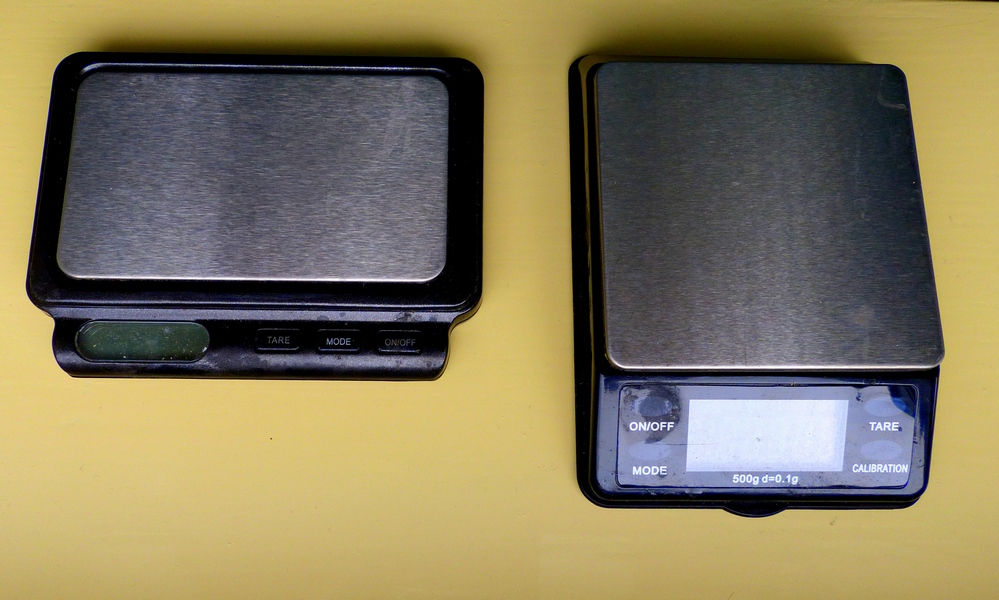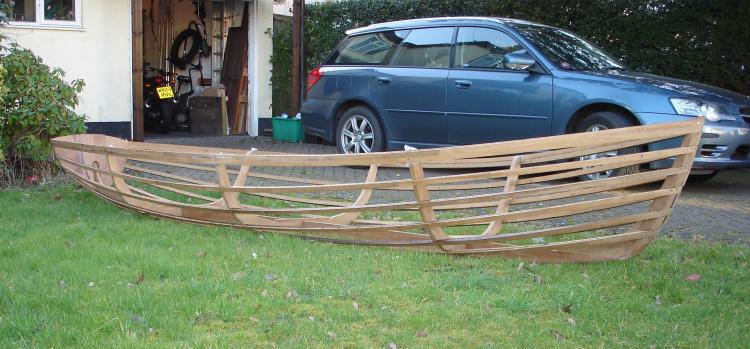Skin on Frame rowing boat
1234
1234
|
|
PS: For example, this evening I mixed up 1.57 grammes of epoxy with 0.71 grammes of hardener, plus some filler powder, to glue a broom head back on for life. A few minutes for the whole job, no waste, no mess, nothing to clean out. There are small jobs like this all the time. Only epoxy will fill the gaps strongly.
Mike |
|
|
Mike,
What digital scales do you recommend for small weights, say up to 0.5kg? I'm stuck with 5kg scales that I steal from the kitchen when my wife is not looking.  They tend to be a bit crude measuring MAS's epoxies, who made a Neanderthal decision to abandon pumps. They tend to be a bit crude measuring MAS's epoxies, who made a Neanderthal decision to abandon pumps.  -Paul |
|
|
Hi Paul,
 They are small electronic, taring platform scales. On the left, 4" x 3", is the 50 gramme scale, 2 decimal places, 2 CR2032 flat batteries, "Truweigh On Balance TW50-A." On the right, 4.5" x 3", is the 500 gramme scale, 1 decimal place, 2 AAA batteries, "On Balance MTT-500". Both model no.s have probably changed by now. I personally need a lot more tiny mixes than bigger ones, down to one gramme, but more usually 3-10 grammes, so I use the 50 gramme scale a lot, for better accuracy. I rarely need a mix over 100 grammes. Each person has to look at his own frequent mix sizes and select a weighing range, e.g. if I had to manage with one scale, I might have one 100 gramme scale, with one decimal place, and borrow the 3000 gramme electronic kitchen platform scale for anything over 100 grammes, which would then be accurate enough. The 3000 gramme scale was £10 from ASDA. For the small scales, I would first search Ebay, then Amazon, and then, if no joy, the Net in general. They will be cheaper than when I bought them, but have not checked recently. I prefer AAA or AA batteries to the flat CR2032 batteries because I always have them around. Sorry, but pumps would be useless for most of my mixes, under 10 grammes. They have no advantage for me, whatever the size of weighing. Regards, Mike |
|
|
Thanks Mike,
One tenth of a gram up to 500 gm suits me. Quick reviews show that coin collectors like the accuracy of them. Paradoxically you can buy calibration weights for a digital scale! -Paul |
|
|
The On Balance MTT-500 was £12 from Amazon. I would have been happy with 1 gram steps and for mixing 2 pack paint a 200 gm pot size is about right.
So 500 gram max and 0.1 gram resolution great. I use the word resolution because I doubt they are accurate at 500 gram, but we don't care for boat building we just want x1 or x2 -Paul |
|
|
MTT-500 for £12 on Amazon - £12.48 postage free on Ebay. It is a great little scale for the price, and if you do any small mixes, the 0.1 gramme resolution is fun and reassuring.
Mike |
|
|
PS, re checking the scales, a 20p coin weighs 5 grammes.
Mike |
|
|
In reply to this post by mike160304
I'll reserve some honey/ketchup dispensers as it does seem the most sensible way of mixing epoxy accurately. I have a digital scale from ATP Instrumentation, bought for a vaguely scientific use but as it goes to 6000g in 1g increments it is ok for epoxy. It can be calibrated to traceable standards which gives me confidence that it is fairly accurate to start with. Also good for weighing parcels.
I wore myself out thinking about the construction method and had to have another big lie down on the sofa, but I've decided to persevere with the original SOF approach and I am now half way through chopping out 60 notches to let the stringers into. The stringers have to sit above the frames but sit flush with the edge of the transom and stem. I've also done a little test with CT-1, recently reviewed in Watercraft, but I'll stick that post in General Discussion later. |
|
|
Alan, thanks for the news.
Re "goes to 6000g in 1g increments it is ok for epoxy." - Even a 3000 gramme scale in 1g resolution is too big for accurate small mixes, if you do any. We have now found a 500g/0.1 resolution scale on Ebay for £12.48 delivered (see above). Mike |
|
|
In reply to this post by mike160304
Mike, I would not be too sure that the weight of coins is reliable enough to calibrate your scales, although I have no evidence. Certainly, the new 5p coins are now magnetic, and may weigh different to the older non-magnetic ones.
Ian |
|
|
Hi Ian, the 20p coin was suggested to me by the vendor, it's good enough to check scales function, but I would not use it for serious calibration. But I don't need calibration - even if I run water absorption tests, e.g. epoxy v PVA, the weighings only need to be comparative not absolute.
Mike |
|
|
I see the MTT-500 will measure in pennyweights!
S |
|
|
In reply to this post by mike160304
I've seen 100 gm calibration weights on the web for under £2
|
|
|
I bought a 300g/0.01g scale from an eBay seller for an incredible £7 delivered. it is about the size and shape of a mobile phone and seems very repeatable. But the display is quite dim and it switches off after a minute, so you have to be a bit quick. I found that I could pour a small random amount of resin, note the weight, then add an accurate quantity of hardener from a syringe. Still don't have squeeze bottles but that has to be the best way.
The problem of laminating stringers on the boat was solved with the use of CT-1 adhesive and working very quickly to get the two bits of wood together before the adhesive skins. I had to remove temporary screws and replace with permanent as I worked from centre to ends, and the two layers were then "clamped" by wrapping with insulation tape. Incredibly messy work - don't wear your best suit. The gunwales are made of the same sections, but laminated two deep and two high, but I will use thickened epoxy for these to give a longer working time. |
|
|
Hi Alan.
To make best use of the short time before the scale switches itself off, I first weigh the resin, write down the weight, and switch the scale off. Then I calculate the hardener weight required and write it down. Then I switch the scale on again and add the exact hardener weight. Mike |
|
|
In reply to this post by Alan
Hi Alan,
Re: "The problem of laminating stringers on the boat was solved with the use of CT-1 adhesive and working very quickly to get the two bits of wood together before the adhesive skins. I had to remove temporary screws and replace with permanent as I worked from centre to ends, and the two layers were then "clamped" by wrapping with insulation tape. Incredibly messy work - don't wear your best suit. " I would use a slow setting epoxy mix giving me 3+ hours working time. I would clamp the laminations together with dozens of cheap plastic spring clamps or cheap market traders' steel spring clamps and leave them on until final cure. Not messy at all, unless I put way too much epoxy on in the first place. Epoxy is only expensive if you have it left over in the pot. I work out the area of jobs in square centimeters and calculate the amount of epoxy to use, e.g.: For a laminated stringer 400 cm long x 2.5 cm wide, I would prime one side with thin MAS Trade A epoxy and coat the other side with the same mix thickened to a sloppy ketchup consistency. That's 1000 square centimeters per side, x .005 = 5g resin for the primed side and x .013 = 13g resin for the filled resin side. Weigh 18g resin, add (x0.45) = 8.1g hardener, prime one side, add filler powder to the rest and coat the other side. After gluing, put plastic or a dust sheet over the hull and a small heat source under the "tent", e.g. I have a 500W Dimplex Coldwatch heater with a thermostat (I use it in the mini-caravan), or one can use 2 or 3 of the old hot 100W light bulbs. The idea is to keep the job at 65-80 degrees F (18-26 degrees C) to help the cure of the slow setting epoxy mix. I don't know why one would use temporary screws followed by permanent screws. Temporary screws can be left in until after epoxy final cure and can then be released by applying a soldering iron to the heads to soften the epoxy round them so that they can be unscrewed and the holes filled afterwards with epoxy. Permanent screws can be put in in the first place and left in forever. A reasonable source for small quantities of A2 stainless screws on Ebay is: http://stores.ebay.co.uk/kaysfasteners [ A4 stainless is not really necessary for dinghies, unless they spend a high percentage of their lives in the water. Mine spend a lot less that 1% or their lives in the water, and the atmosphere in my garage is not especially corrosive, unless I am in a bad temper. ] Mike |
|
|
Thanks Mike, very useful.
The reason for using temp screws for the first layer of the stringers is to see what the boat looks like with all stringers in place. I then made some formers to go between the frames which tweaked their shape until everything looked right. Then permanent screws (plus tape or clamps) to hold the glued second layer. But, I've foolishly chosen to make the whole structure to be dismantled by removing the screws, and I still have to take it apart to varnish the parts individually. If I had decided to glue the whole structure together I would be a lot closer to finishing by now. And now I've injured my back so I'm taking a few days off from the boat. |
|
|
Thanks Alan, sorry to hear you have hurt your back.
Regards, Mike |
|
|
My back is fine now, probably because I am so YOUNG.
Couldn't resist taking the boat out of the garage to see what it looks like right way up. Also did some cleaning up with a plane while it was all in one piece. A few problems to iron out, like screws splitting the wood but very pleased with the shape. 
|
|
|
Very likeable, well done! An "own design" like this is a real challenge.
Mike |
«
Return to Builds in Progress
|
1 view|%1 views
| Free forum by Nabble | Edit this page |

